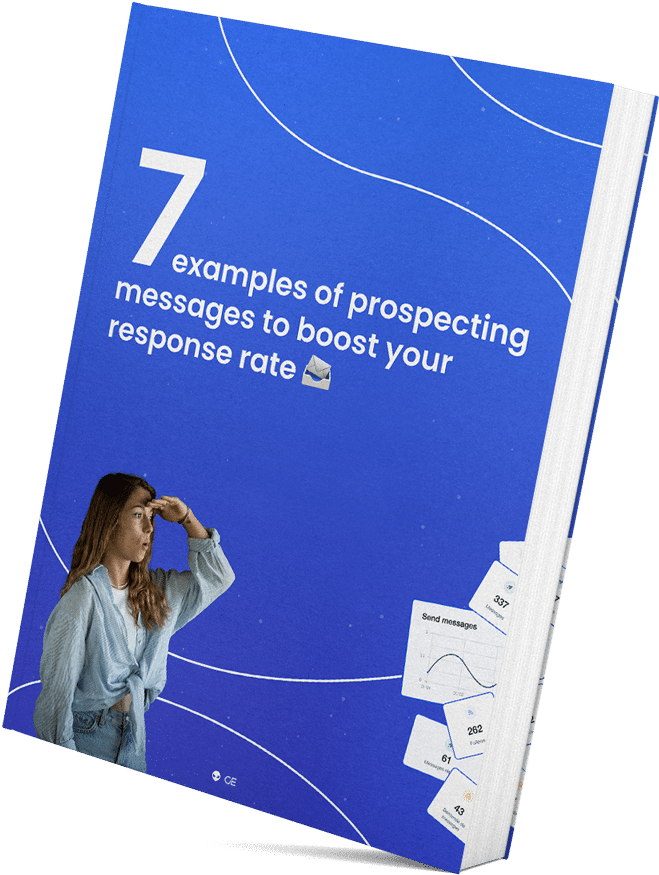You have a marketing strategy in place in your company, and to take it to the next level, you’ve heard about market segmentation. But in reality, you don’t really know what it is (yet). 🤔
One thing’s for sure, you know this one can help you improve your bottom line, and you want to know more. Well, that’s good timing, because you’re in the best place to learn all about this weird proven marketer practice. 🤓
From benefits to implementation, criteria and strategies you can use, we’ll explore the depths of this practice to make you a true expert. Grab a seat, we’re off to take a tour of market segmentation. 🙌

Market segmentation definition
Let’s start by laying the groundwork first. market segmentation involves dividing your customer base into several subgroups (called segments), so that you can target them in a way that is more tailored to their respective profiles.
Basically, you’re adding granularity to your marketing approach, so that it’s more relevant to your target audience, and therefore has more effect on them. 🔥
This is similar to the concept of persona, which is to define the profile of your different types of potential customers and their characteristics. This allows you to provide them with an adapted offer and communication. Each persona represents a customer segment.
You start to understand the benefits of doing your homework well, and knowing your different market segments. And the best part is, there’s more than one. Let’s take a look at this in more detail. 👀
The 5 benefits of market segmentation:
Improve the impact of your messages
There may have been times when you felt like an ad was created just for you, so well did it define your issue. That’s the result of a well-executed market segmentation. 🥳
Inevitably, the impact was much stronger than for a classic ad. Well, that’s the first benefit of segmenting your market the right way.
Your target will feel like they’ve been understood, and the likelihood of them converting is much higher than if you’d just created a generalist ad. 🙌
A better return on your marketing campaigns
Inevitably, who says, more impact in the message, says better conversion rate, which generates a better profitability of your acquisition campaigns.
Whether it is digital marketing such as Google Ads, SMA (Search Media Ads, aka social network advertising) or e-mailing, you have everything to gain by creating campaigns that take into account your customer segments.
So if you want to brag about a high-scoring ROI to your colleagues and boss, you know what you have to do 😉

Create a real relationship with your customer
If your prospect feels understood in the message being sent to them, chances are their esteem for your brand will increase. 🥰
In this way, you lay the foundation for a strong relationship with your customer. This will result in increased loyalty, and it can even create ambassadors for you in some cases.
This one will then start praising your brand to his entourage, simply because you understood him well, and he appreciated it. If it’s not beautiful serious. 😍
Improve your brand image
By implementing the right communication for each of your market segments, you’ll develop a reputation as a brand that’s close to its consumers, understands them, and knows how to help them. 😌
Your communication, the lexical field used, the arguments presented… everything corresponds to what touches your target. The latter then develops a real relationship with you.
You start to stand out from the competition, because you are the only brand to understand your audience so well. And that’s great, because now your target audience doesn’t even question whether they should buy from you or from your competitor. It’s you, and no one else. 😎
Tailor your offer
Having well-defined customer segments will also allow you to create tailored offers. Using the example from earlier with Uber Eat, the offers they put forward depend on the profile of their targets. 🎯
Each person is associated with a market segment based on their ordering habits. The ads, style and marketing channel used correspond to the segment the profile has been associated with.
So if you were wondering why you see pizza in your ads all the time, now you know 😉
The 4 types of market segmentation
It’s all well and good to salivate over all these benefits, but don’t kid yourself. If you don’t set up a quality market segmentation, none of this is going to happen.
And yes, it’s going to take some work to get those results. But you’re in luck, I’m here to show you the shortest path to that idyllic goal. ✨
The first step is going to be to accurately define your marketing segments. And for this, there are four types of criteria you need to know. 👀
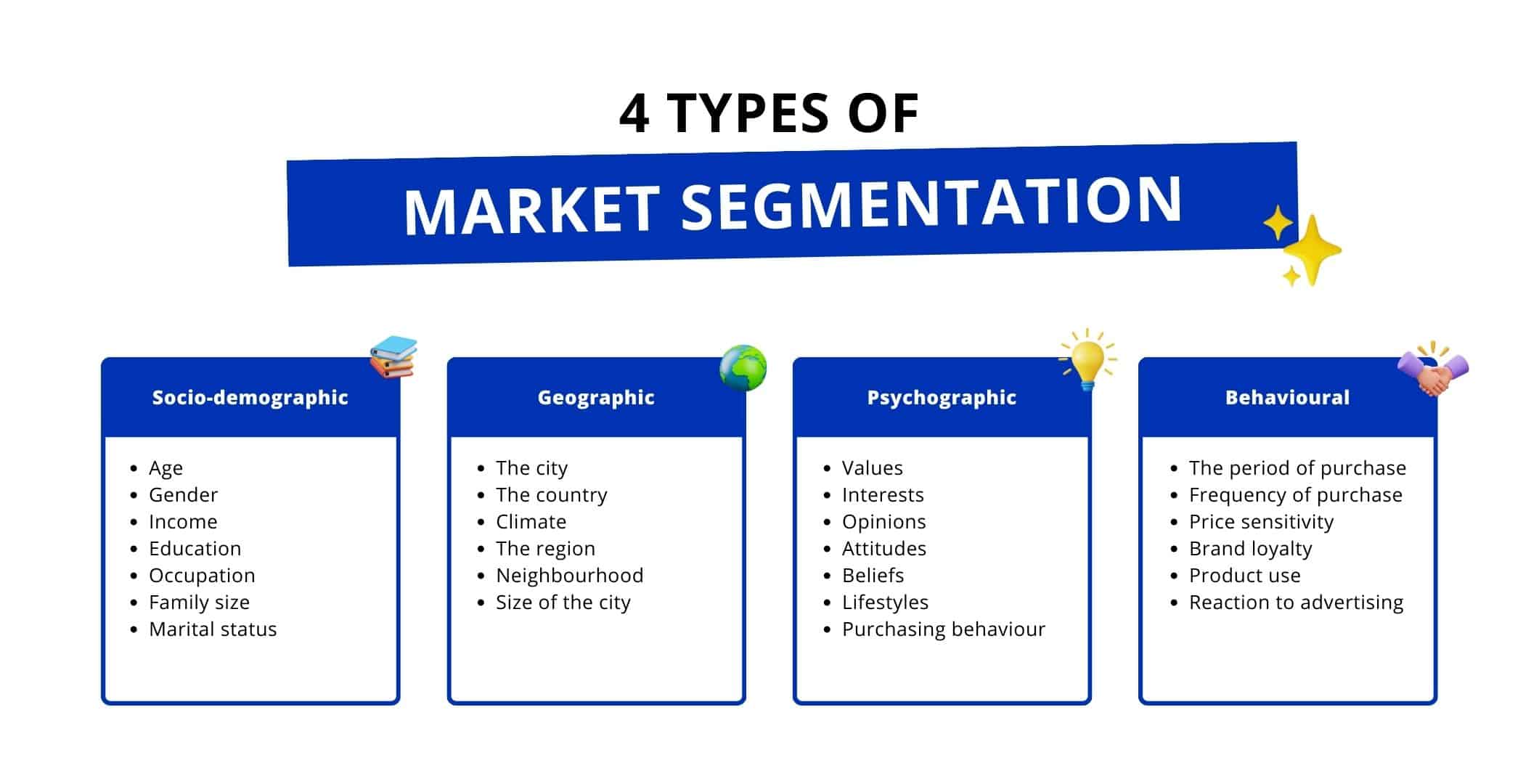
Socio demographic segmentation
Socio-demographic criteria is a good way to start your market segmentation. 👍
These are the “basic” criteria for defining your segments. They involve (among other things) the following characteristics:
- Age.
- Gender.
- Income.
- Education.
- Occupation.
- Family size.
- Marital status
Depending on your industry, these elements presented in the form of a beautiful staircase can potentially impact the way your target consumes your product. This list is not exhaustive. It’s up to you to see what’s relevant to your business. 😊
Geographic segmentation
This segmentation is relatively simple to use. It is based on geographical criteria, which concerns :
- The city.
- The country.
- The climate.
- The region.
- The district.
- The size of the city.
These criteria may be relevant for certain types of business, such as physical stores, or franchises for example. 🏬
If the person has to physically travel to your store to buy your product/service, then I strongly advise you to add these criteria to your market segmentation.
Psychographic segmentation
The psychographic criteria concern the personality of consumers, their way of being and living. 🧠
These criteria are a bit more complex to define, as they are relatively subjective and immaterial. But when they are pertinently used, they can be very powerful.
These criteria can be:
- Values.
- Interests.
- Opinions.
- Attitudes.
- Beliefs.
- Lifestyles.
- Purchasing behaviors.
Anything that helps you understand the psychology behind the consumer’s buying decision falls into this category. This will allow you to propose a copywriting that touches your prospect, and will have more impact on him.
Again, this is not an exhaustive list. If you find other criteria that seem relevant, don’t hesitate to add them! There are no magic recipes 😛

Behavioral segmentation
This type of marketing segmentation is based on tangible data related to the customer’s behavior to define his profile.
This is a very powerful type of segmentation, but to use it, you’re going to need to get data on your customers and analyze it. 📊
The criteria you can use are:
- The purchase period.
- The frequency of purchase.
- Price sensitivity.
- Brand loyalty.
- Product usage.
- Reaction to advertising.
With them, you’ll be able to make decisions based on real data, ensuring your choices are relevant. 😎
Market segmentation: 4 effective strategies you can use
Well, now that we’ve defined our marketing segments, we’ll have to move on to the main course: the segmentation strategy. There is no one better than the others. Whether you’re a B2B or B2C company, you just need to find the one that best fits your needs and means. 🎯
Here are the top 4 market segmentation strategies:
- The classic segmentation strategy.
- The granular segmentation strategy.
- The specific segmentation strategy.
- The personalized segmentation strategy.
Come on, let’s look at each strategy in a little more detail, so that you can choose the one that fits best with knowledge. 🔥
The classic segmentation strategy
The classic market segmentation is to define two or three main segments, and make sure to classify all your personas into these segments.
This is the most commonly used segmentation strategy, mainly because it is easy to implement. We can also talk about multi-segment marketing. 🤓
This strategy corresponds to marketing teams who want to implement a simple and effective segmentation.

The granular segmentation strategy
This strategy takes classic segmentation to a more advanced level. It consists in creating sub-levels within our main marketing segments.
We therefore add granularity (more detail if you will) to our segmentation so that it targets each of our segments more precisely. 🎯
Implementing a granular segmentation strategy requires a deep understanding of your personas, and the differences that exist within them.
But it will also have much more impact on your target, who will really feel like they are understood, as we talked about above. 😛
This then looks like a market segmentation tree like in the illustration below.
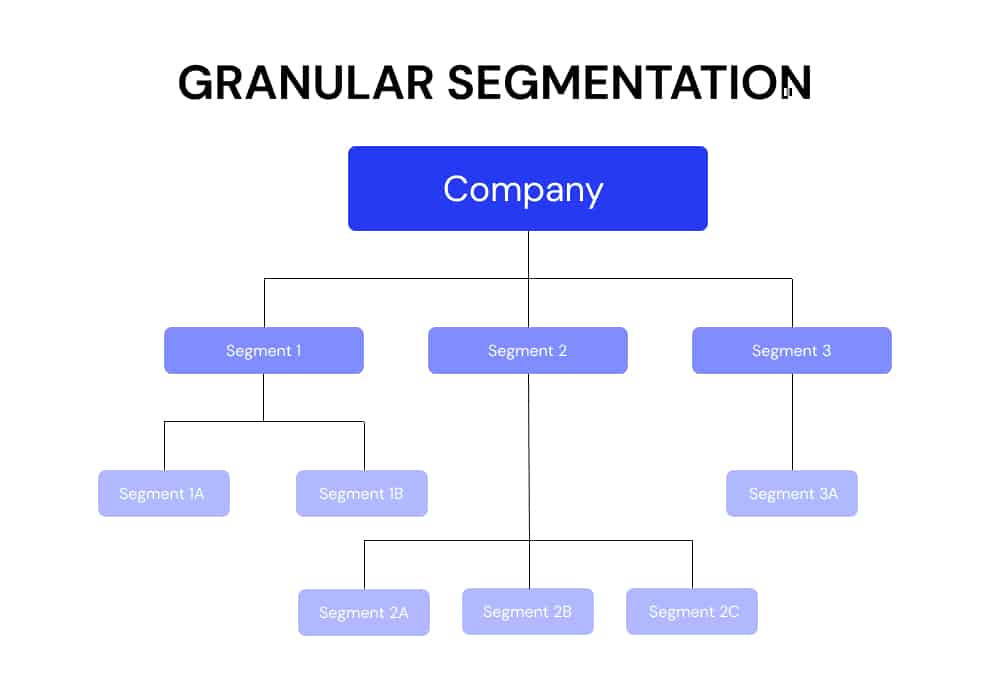
The specific segmentation strategy
The specific segmentation strategy consists in choosing a main segment, and focusing on it by separating it into several sub-segments.
This is an effective technique for companies that position themselves in a very niche sector. This way, the company focuses on the most profitable segment for it and puts aside the secondary segments. 👀
This is ideal for smaller marketing teams, who want to apply Pareto’s Law to their business and put their efforts where they will have the most impact through effective marketing targeting.
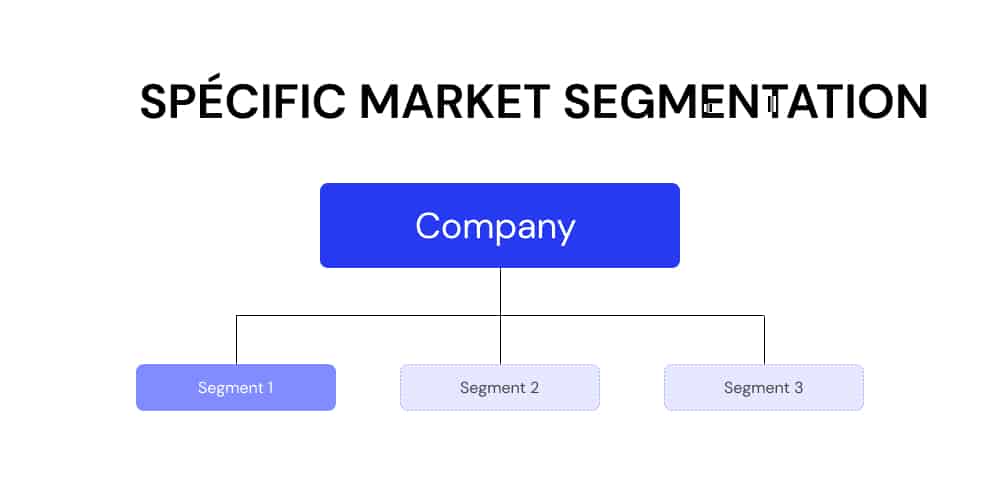
The personalized segmentation strategy
This last strategy consists in establishing a totally personalized segmentation for each customer. So of course, this one doesn’t apply to many businesses.
In particular, it is used for B2B business with few customers, which bring in big sales. 🤑 For a self-employed entrepreneur who manages a few clients, this can be relevant for example.
In these cases, creating a unique strategy for each client is relevant because it allows to increase the revenue generated by these clients, which can represent significant amounts of money. 💶
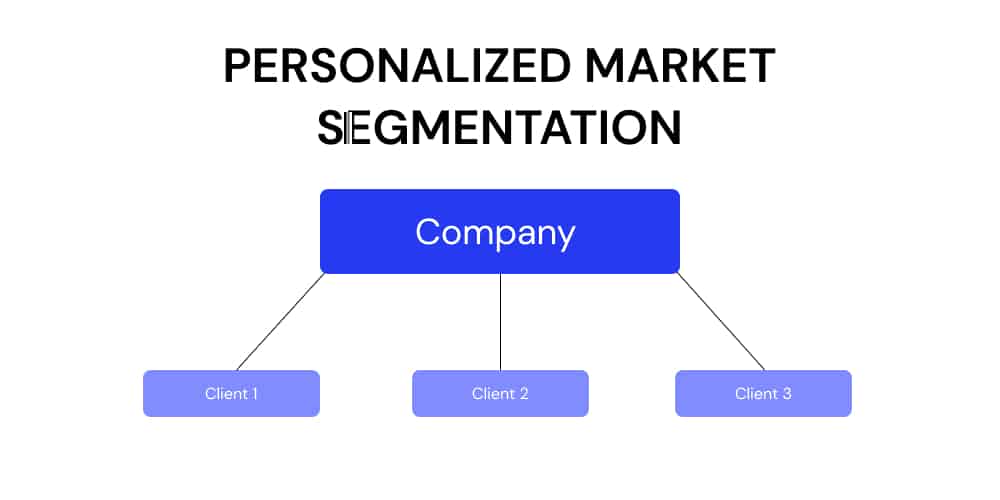
Bonus: Segment your customer base with AI
I’m putting this strategy as a bonus because not many companies can afford to implement it, but it’s extremely effective. 🔥
It involves using AI to create a personalized segmentation for all of your customers, even if you’re a B2C business.
This is the case with Amazon, for example, which makes personalized recommendations based on your last purchases. No one is in charge of creating these offers for you, it’s an AI that does it automatically. Practical 😏
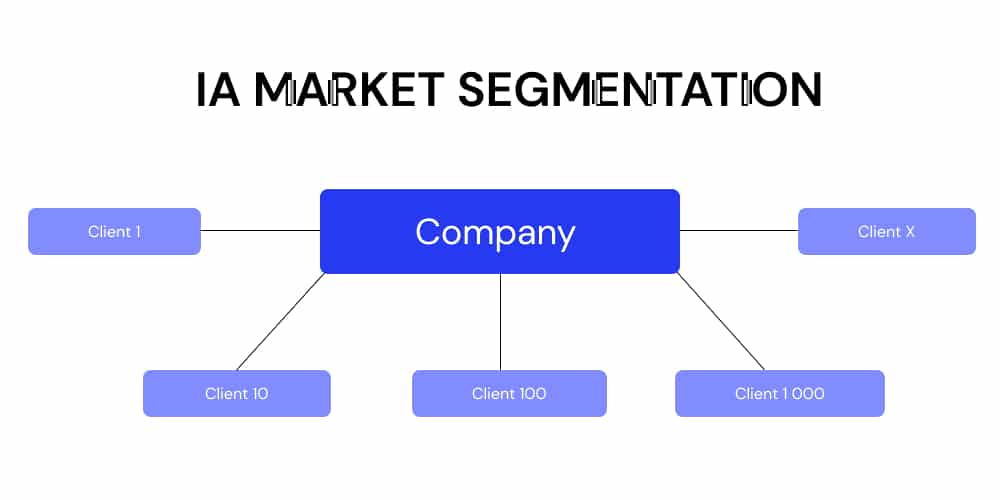
How to set up your market segmentation with Waalaxy?
Now that you know everything about market segmentation, we have one more thing to discuss: how to set it up.
And since I’m spoiling you, here’s a little step-by-step guide to creating and implementing segmentation in your marketing strategy with Waalaxy. 🎁
1. Choose the market segmentation strategy you’re going to use
Start by choosing the strategy you are going to use. You can choose between the 4 we’ve seen below (see all 5 if you can really afford it). 👆
Whether you’re a freelance marketer or the head of a 10-person team, you need to be sure you’re making the right choice. Then you need to ask yourself two questions:
- How diverse is your client base?
- What are the resources at your disposal / the time you want to spend on it?
Based on that, you should find the one that fits your situation more. 🙌
2. Define your personas (aka your customer segments) according to the criteria of markting segmentation
Now that you have chosen your strategy, let’s move on to what we are interested in: your customer segments.
The number you will need to define corresponds to the strategy you have chosen to use. 😊
You will also need to find the relevant criteria in your situation. To do this, simply ask the question “Will this criterion impact my future marketing decisions?”
If yes, then define it as specifically as possible! If not, forget it 😉
3. Search for your prospects on LinkedIn and import them into corresponding lists
Now that you’ve defined your customer segments, you’re going to have to find the people who fit your persona, and import them into your Waalaxy CRM.
For this, you can use the Linkedin search filters. This will already allow you to find your first prospects. You will then be able to import them into Waalaxy through the extension. 🕵️
For even better results, you can also use the Sales Navigator, which will give you access to much more advanced filters. So I know, it’s an expensive tool. But if you’re smart, you can use it… for free. 🤩
We made a dedicated video about it, so if you’re interested, it goes here. 👇
Use Sales Navigator for free 🔥
Otherwise, to import your leads into Waalaxy, nothing could be easier! Just do your search, click on the Waalaxy extension, choose or create the list corresponding to your customer segment, and launch the import! 👽

5. Contact your prospects on LinkedIn with Waalaxy
Well, you’ve now imported your prospects into Waalaxy, so you’ll have to define the best way to contact them.
Think about the tone and the lexical field to use. It has to speak to your target, to maximize your response rate.
Remember to use the information related to the criteria you have defined before! The right keywords can have a very important impact!
Then, create a campaign like “Invitation + 2 messages”, select your list and launch your campaign!
That’s it, Waalaxy is looking for customers for you! You can go relax and wait for the leads to come in. Isn’t life great? 🏝
Remember: a good prospecting message is essentially about your customer, not you!
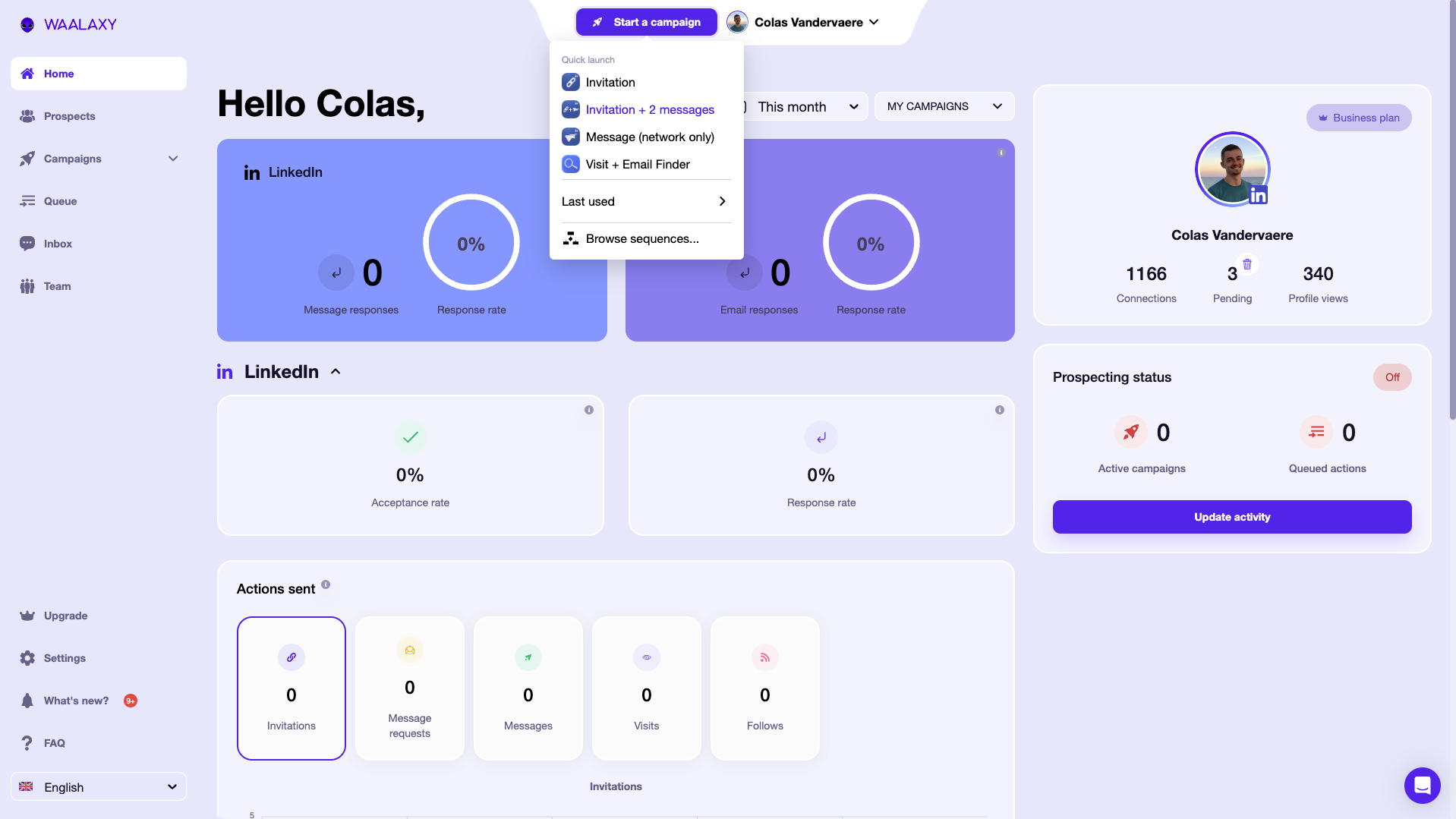
6. Analyze the results of your market segmentation and iterate to find your recipe!
That’s it, you’ve been running your campaigns for a few days, you can start analyzing the results, and make improvements to maximize your campaign performance. 📊
If you had other campaigns in place before, then you can compare your results and calculate the ROI improvement of your marketing actions.
Your market segmentation pays off and your revenue starts to soar. Life is good, you’re moving to the Bahamas and your mom is proud of you. What more could you ask for 😉
Add Waalaxy to Chrome and go to the Bahamas 🏝️

Market segmentation examples
To help you, here is an example of market segmentation. This is the one we have set up at Waalaxy.
We used the classic segmentation strategy, which fits our situation very well. 👌
Our 4 customer segments are:
- CEOs / business leaders.
- Freelancers.
- Recruiters.
- Sales people / marketers.
We have therefore adapted our strategy according to this segmentation. For example, you can find on our blog categories dedicated to each of these profile typologies. Our communication is adapted according to the segment we are addressing.
It’s better for the visitor, because we present him with benefits he understands with an adapted lexical field and tone. It’s also better for us because our message has more impact. Everyone wins! 🏆
Conclusion: What you need to remember about market segmentation
In conclusion, here’s what you need to remember:
market segmentation is a very effective tool to maximize the impact of your outbound marketing campaigns. Whether it’s for prospecting, ad campaigns or cold emailing, you have everything to gain by thinking about your segmentation 🙂
To set it up, choose a strategy adapted to your situation, define the criteria to be used to create your market segmentation, then import your prospects into your Waalaxy CRM. You can then integrate them into automated prospecting campaigns, for free! 🆓
Finally, analyze your results and iterate to find the market segmentation that fits your situation perfectly! 🙌
Quick FAQ about market segmentation
How do I know if market segmentation is right for my business?
market segmentation can only benefit you in your marketing strategy. As long as it helps you to define your personas more precisely, and to target them efficiently, you have everything to gain in my opinion.
Is it essential to do market segmentation?
It’s not “essential” per se, but it’s highly recommended, especially if you are implementing marketing or webmarketing actions as explained above. If you use KPIs to analyze the results of your actions, then you will surely see a clear increase in profitability.
What is a marketing segment?
A marketing segment is a group of people that corresponds to a part of your target audience. You can use the criteria seen above to define it to the maximum.
How many marketing segments should I define?
This depends on the strategy you use. In general, two to three segments are enough to cover 95% of your customer base. But there is no general truth. You know your business better than anyone else, you are the most likely to choose the number of segments to define.
And there you have it, I think you have a lot to do now! I hope you enjoyed this article on market segmentation, and I’ll see you soon for a new article on the Waalaxy blog!







